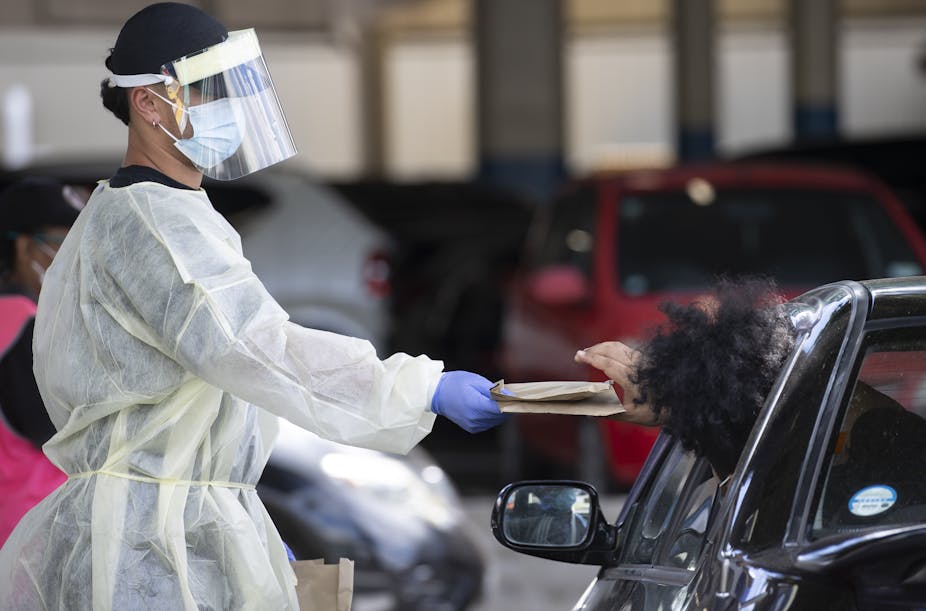New Zealand, Australia and many countries are experiencing a further Omicron wave driven by the latest BA.4/BA.5 subvariants. Our response to this threat is remarkably laissez-faire compared with past approaches, as society has pivoted more to “living with the virus”.
But in both New Zealand and Australia, there’s a real risk current policy settings will be insufficient to prevent health services being overwhelmed – and more will need to be done in coming weeks.
We might squeak through under current policy settings if many more of us get vaccinated, wear masks, and isolate well when sick.
So, how do New Zealand and Australia compare on key policy settings?
Free masks? And what kind?
New Zealand: Free masks for all in Aotearoa – available from testing centres, marae (Māori communal meeting ground) and community centres, and provided directly to schools. Some 16 million surgical masks have been distributed in the last two months, as well as 3 million N95 masks (the latter to high risk and vulnerable people).
Australia: free masks are occasionally distributed to certain groups (for example, some schools might have them). But access is extremely variable. (Also, one of us – Tony Blakely – has been in both Australia and New Zealand in last ten days, and can report mask wearing is much higher in New Zealand.)

Free Rapid Antigen Tests (RATs)?
New Zealand: access is similar to masks. 10.4 million free RATs distributed in last two months.
Australia: the federal government will not extend free rapid antigen tests for concession card holders past July 31. New South Wales and Victoria make RATs available for free for some under certain circumstances. But nationwide, access to free RATs is variable and limited. (One of us – Tony Blakely – received four free RATs on arrival in New Zealand, and zero on arrival in Australia.)
Accessing antivirals (and do you need to go to the GP)?
There are two oral antivirals available in both countries: Paxlovid and Lagevrio.
Both are effective at preventing disease progression (for example, stopping you ending up in hospital) if taken within five days of symptom onset.
New Zealand: available to higher risk groups – access has been expanded from 2% to 10% of cases. Available by prescription from GP and directly from pharmacist. No cost if you’re eligible.
Australia: available to certain higher risk groups. Prescription needed from GP. Co-payment of A$42.50 ($6.80 if concession card).
Vaccines?
Both countries are gradually widening access. Differences in one point in time may not be present in a few weeks. That said, as of mid-July 2022:
New Zealand: primary course (that is, the first two vaccines) available for all people five years and older. First booster available to all 16+ year olds. Second booster (that is, the fourth dose) available to all 50+ year olds (but targeted more to 65+ year olds, unless Māori or Pasifika, in which case all 50+ year olds prioritised). Free. Vaccines mandatory for health and disability sector workers.
Australia: primary course and first booster eligibility the same as in New Zealand. However, second booster encouraged for immunocompromised and all 50+ year olds, and available to 30-49 year olds if they wish. Free. Vaccines mandatory for some workers in some settings.

Income support for people who test positive?
New Zealand: several forms of assistance, including COVID-19 Leave Support Scheme for people who need to self-isolate.
Australia: very restricted availability.
Mask mandates?
New Zealand: mandatory for public transport, retail, visiting health care and aged care facilities, and public venues.
Australia: mandatory in aged and health care settings, on public transport and some other settings (but compliance is low).
Actual mask wearing is higher in indoor environments in New Zealand, based on direct observation in both New Zealand and Victoria by one of us – Tony Blakely – during July.
Mandatory self-isolation?
New Zealand: mandatory seven days self-isolation following positive test result. Household contacts also need to isolate for seven days, unless they have had COVID-19 in the last three months.
Australia: if you test positive for COVID-19 you must immediately isolate. However, the circumstances under which you can leave isolation may depend on which state you’re in. Household members in many places don’t have to isolate, as long as they have no symptoms.

Is either country getting it right?
Based on the above criteria, New Zealand is clearly “winning”. But getting policy settings right over the long haul is about more than just having the most favourable assessment on some selected (but important) criteria.
If the goal is to minimise hospitalisations, deaths and long-term illness, there is an argument for minimising infections by shifting from mitigation towards a suppression strategy.
Longitudinal studies are increasingly showing high rates of reinfection, which carry many of the same health consequences as the initial infection.
As the pandemic goes on (and on and on) we need to increasingly consider cost-effectiveness.
Giving out free RATs to all is a cost to governments, and carries sustainability consequences. Such interventions need to be effective and compared with alternative approaches.
These are complex decisions – and hard to quantify. We do not have a good enough crystal ball to know what is “right” now; we will, unfortunately, only know with the benefit of hindsight.

